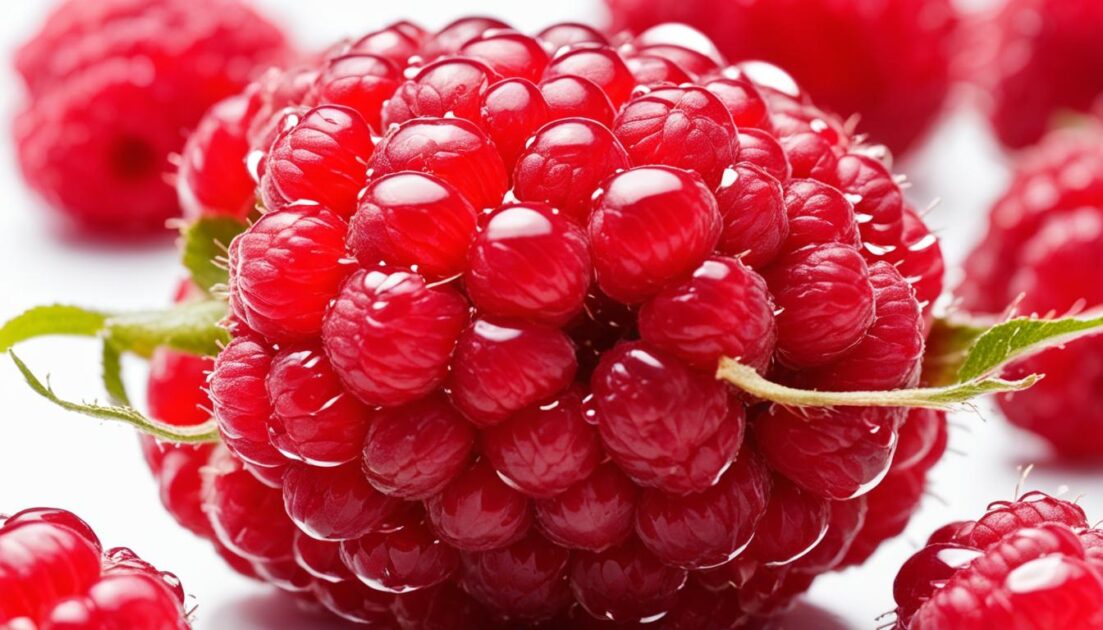When it comes to natural skincare, raspberry seed oil has gained significant attention for its incredible benefits. This powerful oil, derived from the seeds of red raspberries, offers a wide range of advantages for the skin, making it a popular ingredient in many skincare products. With its antioxidant properties, anti-inflammatory benefits, moisturizing effects, and ability to rejuvenate the skin, raspberry seed oil is a powerhouse for promoting healthy and radiant skin.
Key Takeaways:
- Raspberry seed oil is packed with antioxidants that protect the skin from environmental damage.
- It has anti-inflammatory properties that can help soothe and calm irritated skin conditions like eczema and acne.
- The oil provides deep hydration, keeping the skin moisturized and supple.
- Raspberry seed oil offers natural UV protection by filtering out harmful UVA and UVB rays.
- With its high content of essential fatty acids and vitamin E, raspberry seed oil promotes skin rejuvenation and has anti-aging properties.
The Benefits of Red Raspberry Seed Oil for Skin
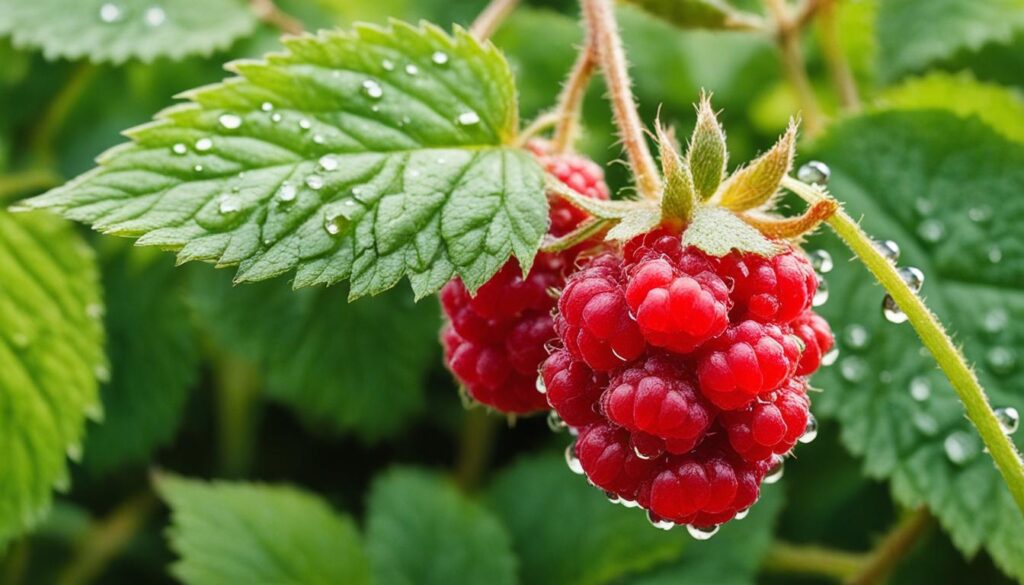
Red raspberry seed oil is a powerful natural ingredient that offers a wide range of benefits for the skin. Its antioxidant properties help protect the skin against damage caused by free radicals, preventing premature aging and promoting a radiant complexion. The oil’s anti-inflammatory benefits make it an excellent choice for soothing and improving various skin conditions, including eczema, psoriasis, and acne.
One of the key benefits of red raspberry seed oil is its moisturizing effects. It provides deep hydration to the skin, leaving it supple, soft, and nourished. Regular use of the oil can help improve skin elasticity and reduce the appearance of fine lines and wrinkles, contributing to a more youthful and rejuvenated complexion.
“Red raspberry seed oil provides deep hydration, leaving the skin supple and nourished.”
In addition, red raspberry seed oil has skin rejuvenation properties. It stimulates cellular growth and promotes the production of collagen and elastin, which are essential for maintaining firm and youthful-looking skin. By incorporating red raspberry seed oil into your skincare routine, you can help enhance your skin’s natural rejuvenation process and achieve a healthier complexion.
The UV protection offered by red raspberry seed oil is another significant benefit. The oil contains natural sun-blocking compounds that filter out UVA and UVB rays, providing an additional layer of defense against harmful sun exposure. Although it cannot replace the need for sunscreen, using red raspberry seed oil alongside your regular sun protection measures can help further safeguard your skin from the damaging effects of the sun.
The impressive benefits of red raspberry seed oil can be attributed to its unique chemical composition. The oil is rich in essential fatty acids, such as omega-3 and omega-6, which help maintain the skin’s barrier function, prevent moisture loss, and support overall skin health. It is also high in vitamin E, a potent antioxidant that protects the skin from oxidative stress and promotes a youthful appearance.
Benefits of Red Raspberry Seed Oil for Skin:
| Benefit | Description |
|---|---|
| Antioxidant Properties | Protects the skin against damage caused by free radicals, preventing premature aging. |
| Anti-inflammatory Benefits | Calms and soothes various skin conditions, including eczema, psoriasis, and acne. |
| Moisturizing Effects | Provides deep hydration, leaving the skin supple, soft, and nourished. |
| Skin Rejuvenation | Stimulates cellular growth, improves skin elasticity, and reduces the appearance of wrinkles. |
| UV Protection | Filters out UVA and UVB rays, offering natural sun protection. |
| Essential Fatty Acids | Helps maintain the skin’s barrier function and supports overall skin health. |
| High Vitamin E Content | Protects the skin from oxidative stress and promotes a youthful appearance. |
With its multitude of benefits, red raspberry seed oil is a valuable addition to any skincare routine. By harnessing the power of nature, this oil can help you achieve healthy, nourished, and radiant skin.
The Chemical Composition of Red Raspberry Seed Oil
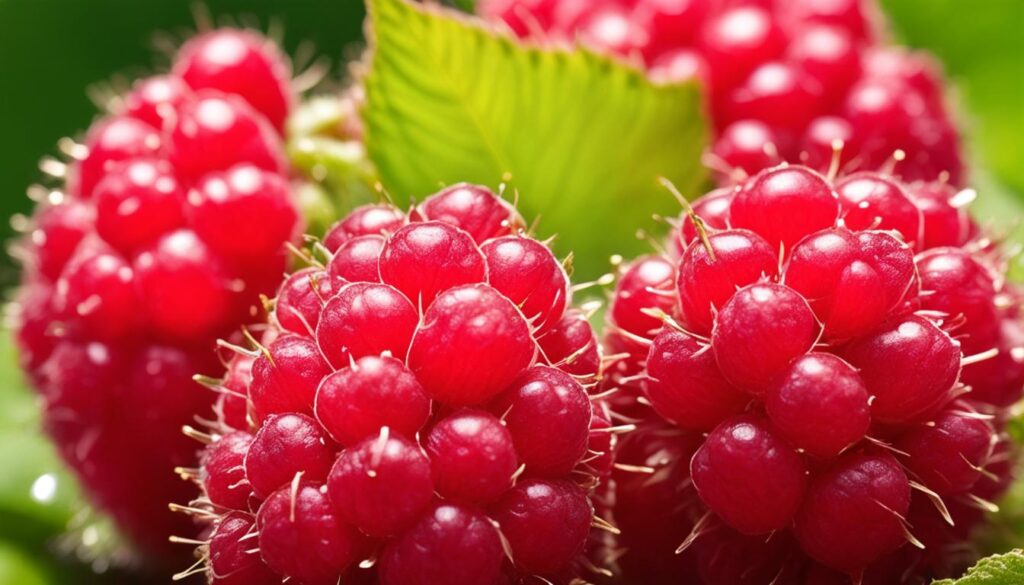
Red raspberry seed oil is a natural oil extracted from the seeds of red raspberries. It contains a rich and diverse chemical composition that contributes to its numerous benefits for the skin. Let’s explore the key components of red raspberry seed oil:
Essential Fatty Acids
Red raspberry seed oil is abundant in essential fatty acids, including omega-3, omega-6, and omega-9 fatty acids. These fatty acids play a crucial role in maintaining the skin’s moisture levels and promoting hydration. They also help strengthen the skin’s natural barrier function, protecting it from environmental stressors and maintaining its overall health.
High Vitamin E Content
Vitamin E, particularly gamma-tocopherol, is highly concentrated in red raspberry seed oil. Vitamin E is a potent antioxidant known for its ability to neutralize free radicals and protect the skin from oxidative damage. It helps promote healthy cell turnover and supports the skin’s natural rejuvenation process.
Antioxidant Properties
With its high vitamin E content and other powerful antioxidants, red raspberry seed oil offers exceptional antioxidant properties. These antioxidants help combat the damaging effects of free radicals, which contribute to premature aging and skin damage. Regular use of red raspberry seed oil can help keep the skin looking youthful and radiant.
Red raspberry seed oil’s chemical composition, rich in essential fatty acids, high vitamin E content, and antioxidant properties, makes it a valuable ingredient for nourishing and protecting the skin.
| Component | Function |
|---|---|
| Essential Fatty Acids | Provide moisture and support the skin’s barrier function |
| Vitamin E | Potent antioxidant that protects against oxidative damage |
| Antioxidants | Combat free radicals and preserve skin’s youthfulness |
The SPF Benefits of Red Raspberry Seed Oil

When it comes to protecting your skin from the harmful effects of the sun, red raspberry seed oil can be a valuable asset. This natural oil offers SPF benefits that make it a popular ingredient in sun care products.
One of the key components of red raspberry seed oil that contributes to its UV protection capabilities is ellagic acid. This compound helps filter out UVA and UVB rays, shielding the skin from their damaging effects.
Research has shown that red raspberry seed oil can provide an SPF value of up to 50, making it an effective natural sunscreen option. However, it is important to note that it cannot replace traditional sunscreen entirely. Instead, it can be used as an additional layer of sun protection when combined with other sun protection measures.
Using red raspberry seed oil alongside your regular sunscreen can provide added benefits, especially for those with sensitive or easily irritated skin. Its natural properties make it a gentle and nourishing option for sun protection.
Keep in mind that while red raspberry seed oil offers sun protection, it is still essential to practice proper sun care habits, such as seeking shade, wearing protective clothing, and reapplying sunscreen regularly.
With its SPF benefits and natural sunscreen properties, red raspberry seed oil can help protect your skin from the damaging effects of the sun while providing nourishment and hydration. Incorporating this oil into your skincare routine can be a valuable step towards maintaining healthy and radiant skin.
Where Red Raspberry Seed Oil Comes From and How It’s Derived
Red raspberry seed oil is derived from the seeds of the Rubus idaeus plant, a shrub native to Asia and Europe. The oil is typically extracted through methods such as cold pressing, steam distillation, or supercritical fluid extraction. Cold pressing and supercritical fluid extraction are preferred as they preserve the oil’s natural properties. The extracted oil has a characteristic red-yellow color due to its carotenoid content.
The Extraction Methods of Red Raspberry Seed Oil
There are several extraction methods used to obtain red raspberry seed oil. One common method is cold pressing, which involves mechanically pressing the seeds to extract the oil. This method is preferred as it retains the oil’s natural properties and nutrients.
Another method is steam distillation, where steam is passed through the raspberry seeds to release the oil. This method is often used for producing essential oils, as it allows for the separation of volatile compounds from the non-volatile ones.
Supercritical fluid extraction is another technique used to extract red raspberry seed oil. In this process, a supercritical fluid, such as carbon dioxide, is used to extract the oil from the seeds. This method is highly efficient and ensures that the oil extracted maintains its quality and beneficial properties.
The Origins of Red Raspberry Seed Oil
The Rubus idaeus plant, also known as the red raspberry plant, is native to Asia and Europe. It is a shrub that produces small, red berries that are rich in nutrients. The seeds of these berries are carefully processed to obtain red raspberry seed oil.
“The extraction methods used for red raspberry seed oil play a crucial role in preserving its natural properties and ensuring its efficacy in skincare products.” – Expert Skincare Consultant
The Chemistry Behind Red Raspberry Seed Oil
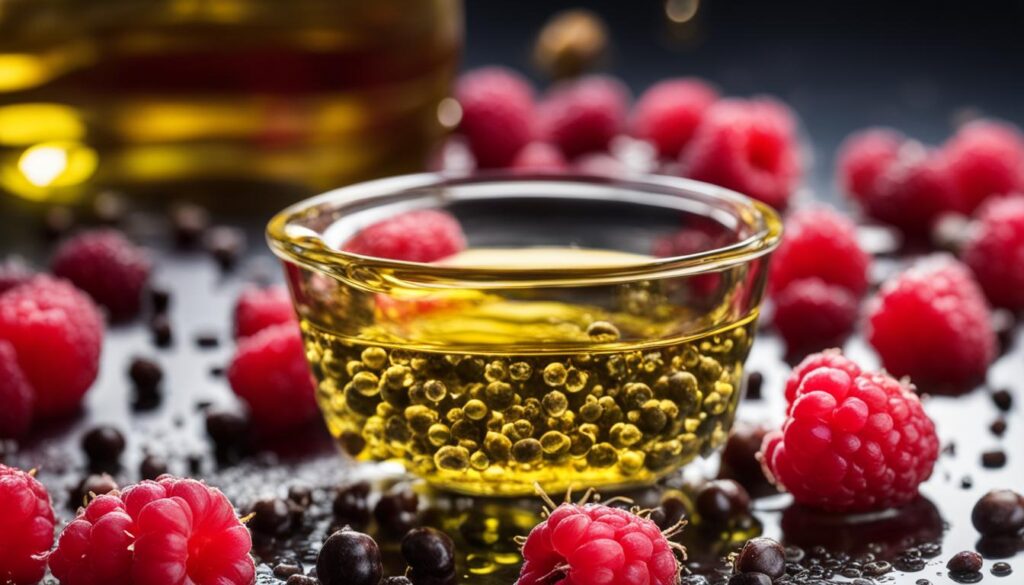
Red raspberry seed oil is hailed for its numerous benefits in skincare. It owes its remarkable properties to a unique blend of compounds that work synergistically to promote healthy and radiant skin. Let’s delve into the chemistry behind red raspberry seed oil and explore the key components that make it so effective.
Essential Fatty Acids: Moisturize and Strengthen
One of the standout features of red raspberry seed oil is its rich content of essential fatty acids. In particular, it is abundant in linoleic acid and alpha-linolenic acid, which are known for their moisturizing and skin-strengthening properties. Linoleic acid helps restore the skin’s natural barrier function, locking in moisture and preventing dryness. Alpha-linolenic acid, an omega-3 fatty acid, contributes to the overall health and resilience of the skin, promoting a smoother and more supple complexion.
Vitamin E: Combatting Aging Effects
Red raspberry seed oil boasts high levels of vitamin E, a potent antioxidant known for its anti-aging properties. Vitamin E helps protect the skin from free radicals, which can lead to premature aging. It supports collagen production, improving the skin’s elasticity and reducing the appearance of fine lines and wrinkles. By incorporating red raspberry seed oil into your skincare routine, you can harness the rejuvenating power of vitamin E for a more youthful complexion.
Polyphenols and Squalane: Antioxidant and Moisturizing Benefits
In addition to essential fatty acids and vitamin E, red raspberry seed oil is also rich in polyphenols and squalane. Polyphenols are potent antioxidants that help neutralize free radicals, protecting the skin from oxidative stress and environmental damage. They contribute to the oil’s anti-aging effects and promote a healthier, more radiant complexion. Squalane, a natural emollient, works to lock in moisture, keeping the skin hydrated and nourished. Both polyphenols and squalane further enhance the moisturizing benefits of red raspberry seed oil, leaving the skin soft, smooth, and supple.
| Key Components | Benefits |
|---|---|
| Essential Fatty Acids | Moisturize and strengthen the skin |
| Vitamin E | Combat aging effects, support collagen production |
| Polyphenols | Provide antioxidant protection, promote a healthier complexion |
| Squalane | Lock in moisture, enhance skin hydration |
By harnessing the powerful combination of essential fatty acids, vitamin E, polyphenols, and squalane, red raspberry seed oil offers a myriad of benefits for the skin. Whether it’s moisturizing and strengthening the skin, combating aging effects, or providing antioxidant protection, this natural oil is a valuable asset in your skincare arsenal.
Common Queries About Using Red Raspberry Seed Oil
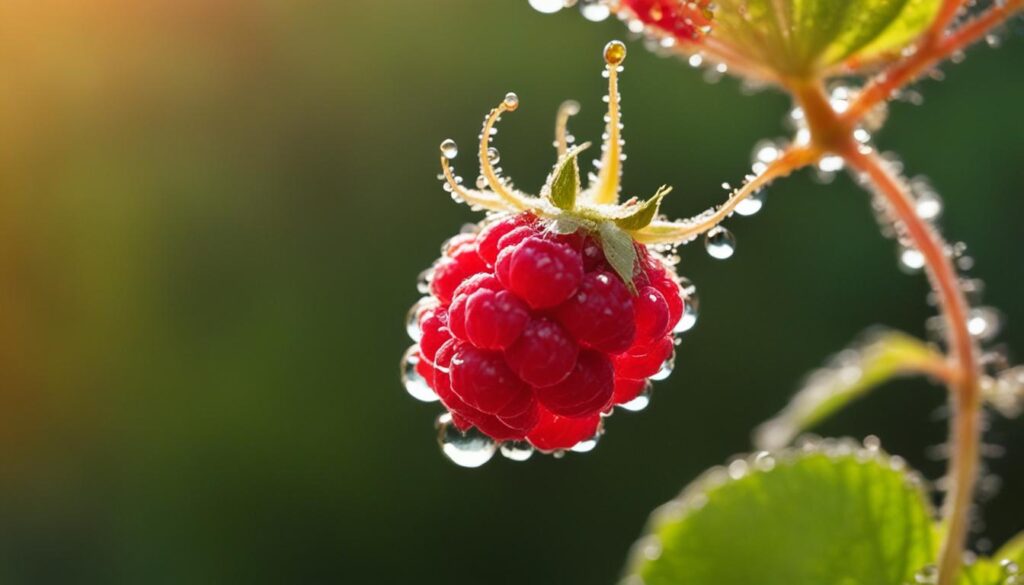
As a skincare enthusiast, you may have some questions and concerns about incorporating red raspberry seed oil into your routine. Let me address some of the common queries:
- Is red raspberry seed oil comedogenic?
- Can red raspberry seed oil replace sunscreen?
- Is red raspberry seed oil a good moisturizer?
- Is red raspberry seed oil suitable for all skin types?
Many people worry about oils clogging their pores, but rest assured that red raspberry seed oil has a low comedogenic rating. It is unlikely to cause breakouts or congestion, making it suitable for all skin types.
While red raspberry seed oil has natural sun-filtering properties, it should not be relied upon as a standalone sunscreen. To protect your skin adequately from harmful UV rays, it is essential to use a dedicated sunscreen with broad-spectrum protection. Consider red raspberry seed oil as a supplement to your sunscreen routine for added sun protection benefits.
Yes, red raspberry seed oil can serve as a moisturizer, but its effectiveness may vary depending on individual skin type. It provides hydration and nourishment to the skin, leaving it soft and supple. However, if you have extremely dry skin, you may need to layer it with a heavier moisturizer to ensure optimal hydration.
Absolutely! Red raspberry seed oil is safe to use for all skin types, including oily, combination, and acne-prone skin. Its lightweight texture and non-greasy formula make it a versatile option for everyone seeking the benefits of this remarkable oil.
By addressing these common queries, I hope to have provided you with the necessary information to confidently incorporate red raspberry seed oil into your skincare routine.
Benefits of Red Raspberry Seed Oil for Skin
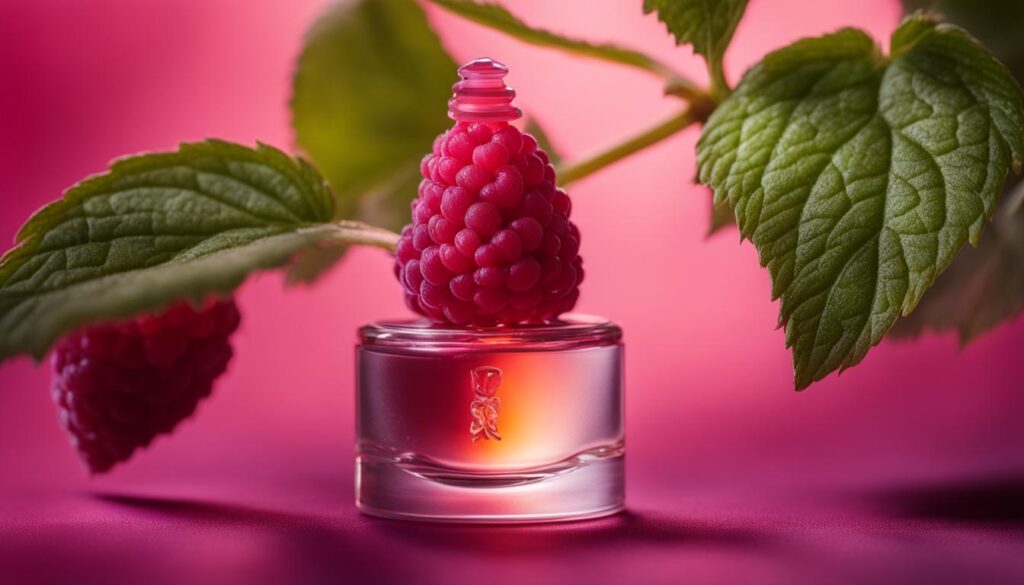
Red raspberry seed oil is a powerhouse when it comes to skin benefits. From its anti-aging properties to its ability to repair the skin barrier, this oil has it all. Let’s explore the incredible effects of red raspberry seed oil on the skin.
Anti-Aging Properties
One of the key benefits of red raspberry seed oil is its anti-aging properties. The oil is rich in antioxidants that help fight against free radicals, which can cause premature aging. By incorporating red raspberry seed oil into your skincare routine, you can reduce the appearance of wrinkles and promote a more youthful and radiant complexion.
Skin Barrier Repair
The skin’s barrier serves as a protective shield against environmental aggressors and helps retain moisture. Red raspberry seed oil is known for its ability to repair and strengthen the skin’s barrier, improving its overall health and function. This oil nourishes the skin, leaving it soft, supple, and better equipped to defend against external stressors.
Antioxidant Effects
Red raspberry seed oil is packed with antioxidants that provide a shield against damage caused by free radicals. These harmful molecules can lead to skin aging and other skin concerns. By incorporating red raspberry seed oil into your skincare routine, you can protect your skin from oxidative stress and maintain a more youthful appearance.
Anti-Inflammatory Effects
Inflammation is a common issue that can lead to skin irritation, redness, and discomfort. Red raspberry seed oil has anti-inflammatory properties that help soothe and calm irritated skin. Whether you’re dealing with acne, eczema, or other inflammatory skin conditions, red raspberry seed oil can provide relief and promote a healthier skin complexion.
Overall, the benefits of red raspberry seed oil for the skin are truly remarkable. From its anti-aging properties to its ability to repair the skin barrier, this oil offers a range of advantages. Incorporating red raspberry seed oil into your skincare routine can help you achieve healthier, more vibrant skin.
Chemical Composition and Nutritional Value of Red Raspberry Seed Oil
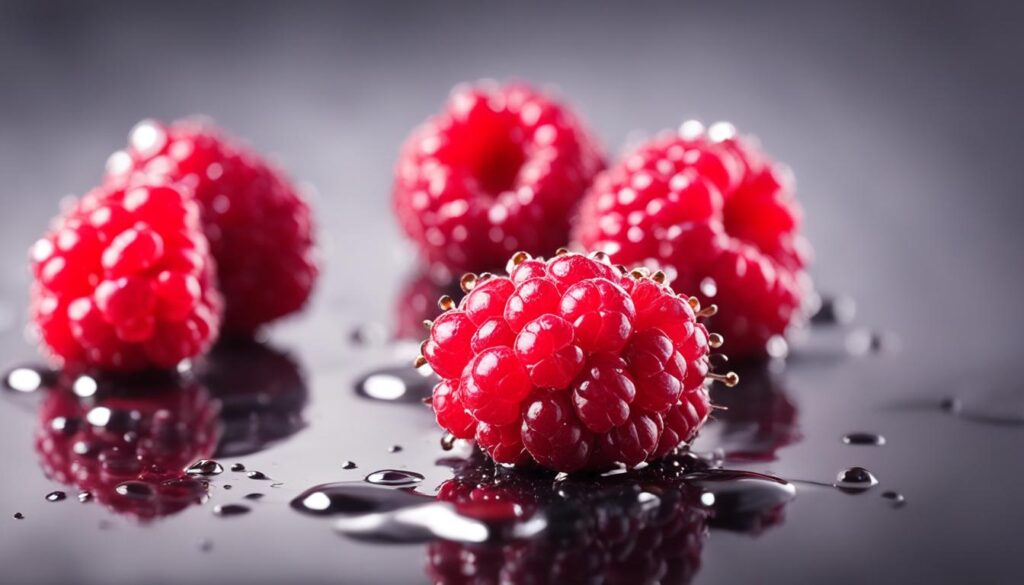
Red raspberry seed oil is not only beneficial for the skin but also offers significant nutritional value. It is rich in essential fatty acids, vitamin E, and polyphenols, which all play a vital role in maintaining overall health and well-being.
The essential fatty acids present in red raspberry seed oil, such as omega-3, omega-6, and omega-9 fatty acids, are crucial for various bodily functions. These fatty acids are known to support cardiovascular health, reduce inflammation, and improve brain function.
Vitamin E, another key component of red raspberry seed oil, is a powerful antioxidant that helps protect cells from free radical damage. It also supports the immune system and promotes healthy skin and hair.
Polyphenols, a group of plant compounds found in red raspberry seed oil, have been extensively studied for their antioxidant properties. These compounds help fight oxidative stress, reduce inflammation, and may have potential anticancer effects.
When it comes to nutritional value, red raspberry seed oil serves as an excellent source of essential fatty acids, vitamin E, and polyphenols. Including this oil in your diet can contribute to a balanced nutrient intake and enhance overall well-being.
Raspberry Seed Oil Nutritional Composition:
| Nutrient | Amount per 100g |
|---|---|
| Essential Fatty Acids | 60g |
| Vitamin E | 100mg |
| Polyphenols | 150mg |
With its abundance of essential fatty acids, vitamin E, and polyphenols, red raspberry seed oil offers not only remarkable benefits for the skin but also adds value to a nutritious diet. Incorporating this oil into your daily routine can help nourish your body inside and out.
Extraction and Production of Red Raspberry Seed Oil
Extracting red raspberry seed oil involves a careful process that ensures the preservation of its natural properties. The oil is derived from the seeds of red raspberries, which are known for their high content of antioxidants and essential fatty acids. Two common methods used in the extraction process include cold pressing and supercritical fluid extraction.
Cold pressing is a popular method for extracting red raspberry seed oil. In this process, the seeds are mechanically pressed at low temperatures to extract the oil. Cold pressing is preferred as it minimizes heat exposure, which can degrade the oil’s beneficial compounds. This method helps maintain the oil’s quality, ensuring it retains its antioxidant properties and essential fatty acids.
Supercritical fluid extraction is another method used to extract red raspberry seed oil. This process involves using supercritical carbon dioxide as a solvent to extract the oil from the seeds. Supercritical fluid extraction is a more advanced technique that allows for precise control over temperature and pressure, resulting in a high-quality oil with preserved nutritional and therapeutic properties.
Once the oil is extracted, it goes through a production process to refine and purify it. This process involves removing impurities, such as solids and unwanted compounds, to create a high-quality oil suitable for use in skincare formulations. The refined red raspberry seed oil is then packaged and made available for commercial use.
The extraction and production of red raspberry seed oil result in a versatile and beneficial product that can enhance skincare routines. Its natural properties, derived from carefully extracted seeds, make it a valuable ingredient that can nourish, protect, and rejuvenate the skin.
Summary Table: Extraction Methods and Production Process of Red Raspberry Seed Oil
| Extraction Method | Advantages |
|---|---|
| Cold Pressing | Preserves natural properties, maintains antioxidant and essential fatty acid content |
| Supercritical Fluid Extraction | Allows for precise control, produces high-quality oil with preserved nutritional and therapeutic properties |
| Production Process | Refines and purifies the oil, removes impurities for a high-quality product |
Conclusion
In conclusion, red raspberry seed oil offers a wide range of benefits for the skin. Its antioxidant properties help protect the skin from damage caused by free radicals, while its anti-inflammatory benefits soothe and calm irritated skin. Additionally, the moisturizing effects of red raspberry seed oil promote hydration and a more supple complexion.
This natural skincare ingredient is not only nourishing but also provides UV protection. The oil’s ability to filter out UVA and UVB rays makes it a valuable addition to any sun protection regimen. Furthermore, red raspberry seed oil is rich in essential fatty acids and high in vitamin E content, both of which contribute to its anti-aging properties and ability to support skin rejuvenation.
Incorporating red raspberry seed oil into your skincare routine can help unlock the secret to radiant skin. Its combination of antioxidant, anti-inflammatory, moisturizing, and UV-protective benefits make it a versatile and effective option. Discover the natural wonders of red raspberry seed oil and experience the transformative effects it can have on your skin.
FAQ
What are the benefits of using red raspberry seed oil for skin?
Red raspberry seed oil provides antioxidant protection, anti-inflammatory effects, hydration, and UV protection for the skin. It also helps in skin rejuvenation and offers moisturizing effects.
Does red raspberry seed oil contain any antioxidants?
Yes, red raspberry seed oil is rich in antioxidants, which help protect the skin against damage from free radicals and environmental stressors.
Can red raspberry seed oil help with skin conditions such as eczema and acne?
Yes, red raspberry seed oil has anti-inflammatory properties that can be beneficial for skin conditions like eczema, psoriasis, and acne.
Is red raspberry seed oil a good moisturizer?
Yes, red raspberry seed oil provides deep hydration to the skin, promoting a moisturized and supple appearance.
Does red raspberry seed oil offer UV protection?
Yes, red raspberry seed oil has natural UV-filtering properties and can provide some sun protection. However, it should be used as a supplement to traditional sunscreen.
What compounds are found in red raspberry seed oil?
Red raspberry seed oil contains essential fatty acids, high levels of vitamin E, polyphenols, and squalane.
Can red raspberry seed oil be used for all skin types?
Yes, red raspberry seed oil is safe to use for all skin types, including oily, combination, and acne-prone skin.
How does red raspberry seed oil benefit the skin?
Red raspberry seed oil offers anti-aging properties, helps repair and strengthen the skin’s barrier, provides antioxidant effects, and soothes irritated skin with its anti-inflammatory effects.
Does red raspberry seed oil have any nutritional value?
Yes, red raspberry seed oil is rich in essential fatty acids, vitamin E, and polyphenols, which provide nutritional value and positive effects on overall health.
How is red raspberry seed oil derived?
Red raspberry seed oil is typically extracted through methods such as cold pressing, steam distillation, or supercritical fluid extraction.
